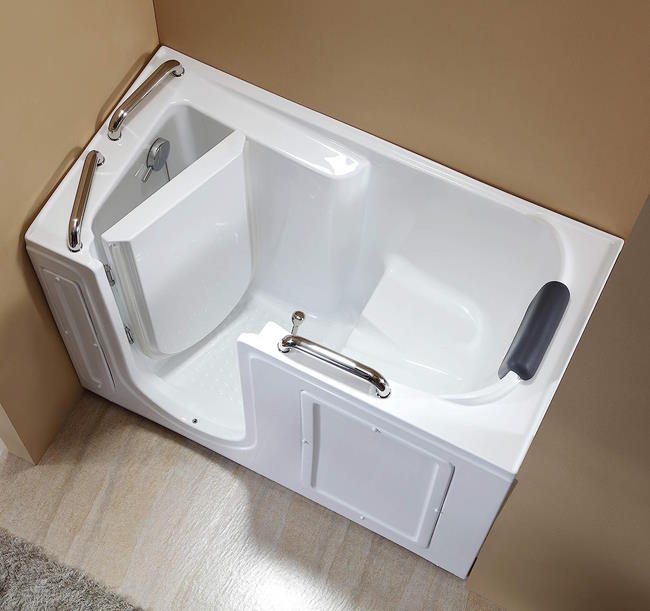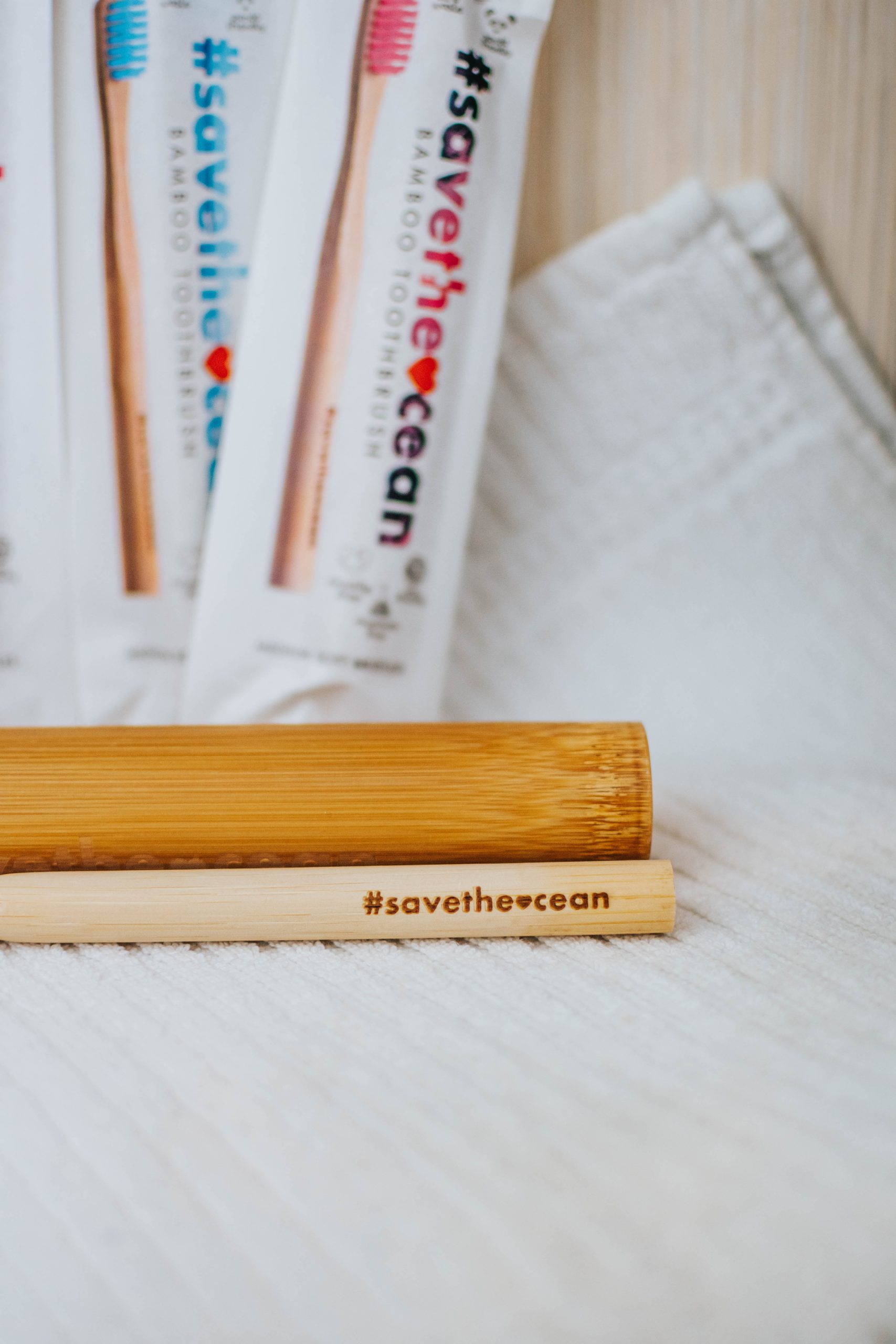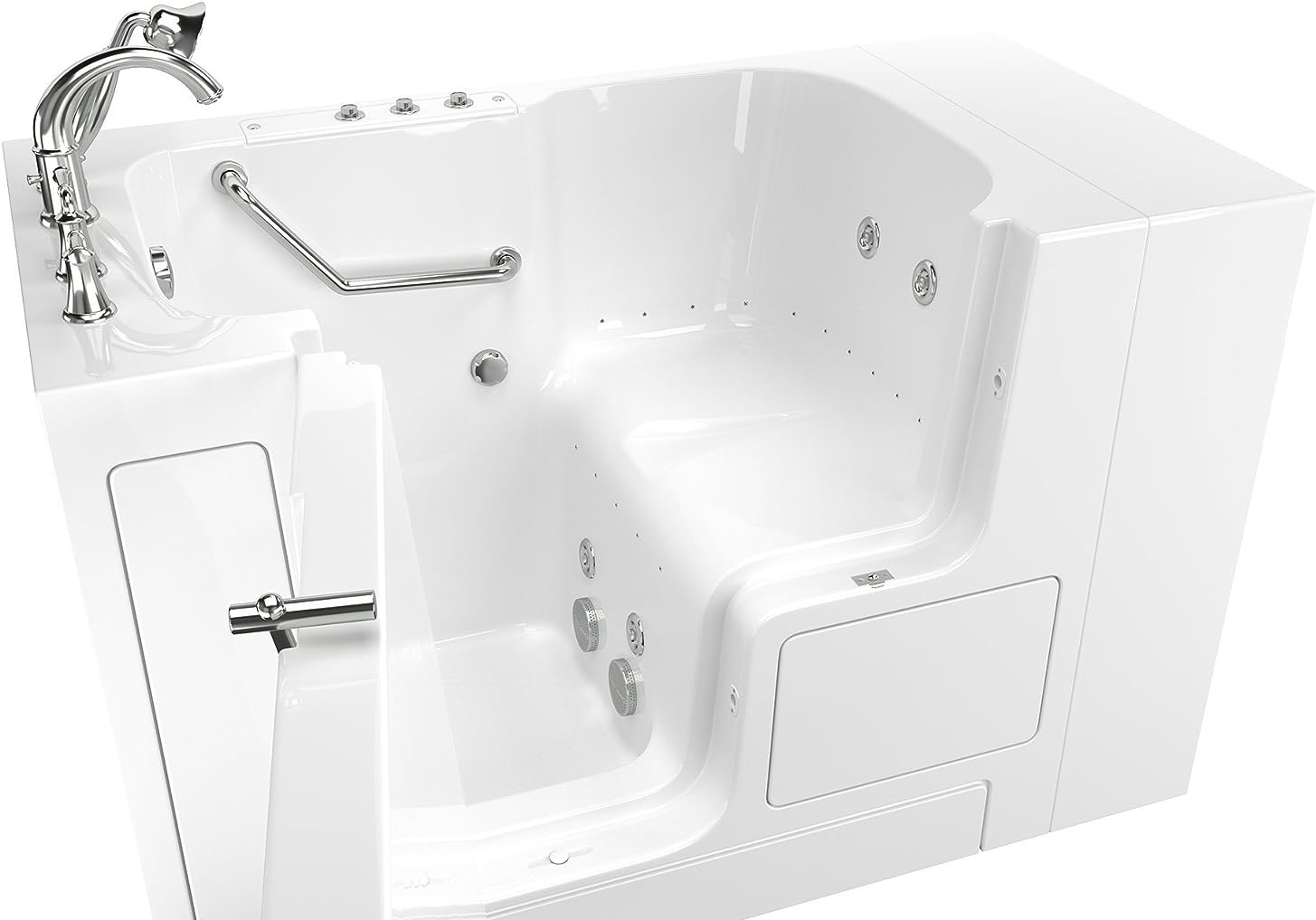If you’re looking for a way to minimize your environmental impact while still enjoying a luxurious bathing experience, then Environmental Impact Eco-Friendly Bathing is the article for you. Filled with valuable information about water usage and its effects on the environment, this article explores how walk-in tubs can be a sustainable and eco-friendly choice for your bathing needs. Discover the benefits of these innovative tubs and learn how you can contribute to a greener future without compromising on comfort and convenience.

Water Usage in Walk-In Tubs
Walk-in tubs are a popular choice for individuals who have mobility issues or physical disabilities. These tubs offer a safe and convenient bathing solution, allowing you to enjoy a relaxing soak without the fear of slipping or falling. One of the main concerns when it comes to walk-in tubs is their water usage. Let’s explore the average water usage of these tubs and the water-saving features that can help you conserve water.
Average water usage
The average water usage of a walk-in tub varies depending on the size and model. On average, a walk-in tub requires between 40 and 80 gallons of water per use. This may seem like a lot compared to a traditional bathtub, which typically holds around 30 gallons of water. However, it’s important to consider the unique features of walk-in tubs that contribute to their water usage.
Water-saving features
Walk-in tubs often come equipped with various water-saving features. These features are designed to reduce water consumption without compromising on your bathing experience. One common water-saving feature is a built-in water depth control system that allows you to adjust the water level according to your preference. This ensures that you only use the necessary amount of water for your bath.
Another water-saving feature found in some walk-in tubs is a quick-fill and quick-drain system. This system allows you to fill and drain the tub rapidly, minimizing the amount of time and water needed for each use. Additionally, some walk-in tubs are equipped with aerated jets that create a swirling effect, reducing the amount of water needed while still providing a therapeutic massage experience.
Comparison with traditional bathtubs
When comparing the water usage of walk-in tubs with traditional bathtubs, it’s essential to consider the specific needs and challenges of individuals who require a walk-in tub. Traditional bathtubs are not designed with accessibility in mind, making them impractical and unsafe for many people. While walk-in tubs may use slightly more water, the benefits they provide in terms of safety and convenience outweigh the minimal increase in water usage.
It’s also worth mentioning that the water-saving features of walk-in tubs mentioned earlier can help minimize the difference in water usage between walk-in tubs and traditional bathtubs. These features allow you to customize the amount of water used and maximize efficiency.
Environmental Considerations
When considering any home appliance or fixture, it’s important to evaluate its environmental impact. Walk-in tubs are no exception, and several factors must be taken into account, including water conservation, energy consumption, and chemical usage.
Water conservation
Water conservation is a significant concern when it comes to walk-in tubs. As mentioned earlier, these tubs can require a substantial amount of water per use. However, with the water-saving features mentioned previously, you can still make an effort to conserve water. By adjusting the water level and utilizing the quick-fill and quick-drain system, you can reduce the overall water consumption of your walk-in tub.
Additionally, being mindful of your bathing habits can contribute to water conservation. If you are able to take shorter baths or limit the frequency of your bath, you can further reduce your water usage without compromising your hygiene or comfort.
Energy consumption
In addition to water usage, it’s crucial to consider the energy consumption associated with walk-in tubs. These tubs typically require electricity to power their various features, such as the jets and the heating system. While the energy consumption of walk-in tubs can vary depending on the model, many manufacturers have implemented energy-efficient features to minimize energy usage.
For example, some walk-in tubs come with insulation materials that help retain heat, reducing the need for constant reheating. Additionally, programmable timers and thermostats allow you to control the energy usage of your tub, ensuring it is only powered when needed.
Chemical usage
Chemical usage in walk-in tubs is another important environmental consideration. Many individuals rely on chemicals, such as chlorine or other sanitizing agents, to keep their tubs clean and free from bacteria. However, these chemicals can be harmful to both your health and the environment.
When choosing a walk-in tub, opt for models that utilize safe alternatives to traditional cleaning agents. For example, some tubs come equipped with self-cleaning mechanisms that use ozone or UV light to eliminate bacteria, reducing the need for additional chemicals. By choosing a tub with these innovative cleaning methods, you can minimize the environmental impact associated with chemical usage.
Benefits of Eco-Friendly Bathing
Opting for an eco-friendly walk-in tub not only contributes to a healthier environment but also offers several benefits for you as the user.
Reduced water waste
By utilizing the water-saving features of eco-friendly walk-in tubs, you can significantly reduce water waste. Adjusting the water level and utilizing the quick-fill and quick-drain system allows you to use only the necessary amount of water for each bath. This not only conserves water but also helps lower your water bills.
Lower energy consumption
Eco-friendly walk-in tubs often come equipped with energy-efficient features that help reduce energy consumption. Insulation materials and programmable timers ensure that your tub uses energy only when needed. By reducing your energy usage, you not only contribute to a greener environment but also save on your energy bills.
Healthier bathing experience
In addition to the environmental benefits, eco-friendly walk-in tubs can provide a healthier bathing experience. By minimizing the usage of chemicals and utilizing alternative cleaning methods, you can avoid exposing yourself to potentially harmful substances. This is particularly beneficial for individuals with sensitive skin or allergies.
Water Usage in Walk-In Showers
While walk-in tubs offer many benefits, walk-in showers are another viable option to consider. Walk-in showers provide a practical and efficient bathing solution, particularly for individuals who prefer standing or have mobility challenges that make getting in and out of a tub difficult. Let’s explore the water usage and water-saving features associated with walk-in showers.
Water-saving features
Walk-in showers often come equipped with various water-saving features that allow you to conserve water without sacrificing your bathing experience. One common feature is a low-flow showerhead that limits the flow of water while still providing adequate water pressure. This helps reduce water consumption without compromising your showering experience.
Some walk-in showers also incorporate temperature control systems that allow you to set and maintain your desired water temperature. This helps minimize water waste by preventing the need for continuous adjustment of the hot and cold water.
Comparison with walk-in tubs
When comparing the water usage of walk-in showers with walk-in tubs, it’s important to consider your personal bathing preferences and needs. Walk-in tubs require more water per use compared to walk-in showers, as they are designed to provide a full soaking experience. However, if you prefer quick showers over long baths, a walk-in shower may be a more water-efficient option for you.
Ultimately, the choice between a walk-in tub and a walk-in shower depends on your individual circumstances and bathing preferences. Consider factors such as mobility, safety, and water usage when making your decision.

Impact of Walk-In Tubs on Water Resources
It’s essential to consider the impact of walk-in tubs on water resources, particularly in areas where water scarcity is a pressing concern. While walk-in tubs provide numerous benefits, their water usage can put pressure on local water supplies and potentially contribute to water shortages. Let’s explore the potential impact of walk-in tubs on water resources and discuss solutions for sustainable usage.
Pressure on local water supply
Walk-in tubs, particularly in areas with dense populations, can place a strain on the local water supply. The increased water usage associated with these tubs can contribute to the depletion of water resources, exacerbating water scarcity issues. This is especially concerning in regions where water is already scarce or where droughts are common.
Potential for water shortages
The potential for water shortages is a significant concern when it comes to walk-in tubs. With an aging population and an increasing demand for accessible bathing solutions, the usage of walk-in tubs is expected to rise. If not managed properly, this increased demand could lead to even greater pressure on water resources and potentially result in water shortages.
Solutions for sustainable usage
To ensure sustainable usage of walk-in tubs and minimize their impact on water resources, it’s important to implement water conservation measures. This includes utilizing the water-saving features of walk-in tubs, adjusting the water level according to your needs, and being mindful of your bathing habits.
Additionally, investing in educational programs and initiatives that promote water conservation can help raise awareness and encourage responsible water usage. This, coupled with proper water management strategies on a larger scale, can contribute to sustainable use of walk-in tubs without compromising the comfort and safety they provide.
Energy Consumption of Walk-In Tubs
In addition to water usage, the energy consumption of walk-in tubs is another crucial aspect to consider. As previously mentioned, walk-in tubs often require electricity to power their various features. Let’s explore the energy consumption associated with walk-in tubs and the measures that can be taken to minimize it.
Heating and electricity usage
Walk-in tubs typically rely on electricity to power their heating systems, jets, and other features. The energy consumption associated with walk-in tubs can vary depending on the model and the frequency of use. It’s important to consider not only the initial energy required to heat the water in the tub but also the continuous energy needed to maintain the desired temperature.
Energy-efficient features
Many manufacturers have recognized the importance of energy efficiency and have implemented features to minimize the energy consumption of walk-in tubs. For example, some walk-in tubs come with insulation materials that help retain heat, reducing the need for constant reheating. Programmable timers and thermostats allow users to control when their tubs are powered, optimizing energy usage.
Considering these energy-efficient features when selecting a walk-in tub can help reduce the overall energy consumption and lower your energy bills. It’s always recommended to look for products that have earned energy efficiency certifications or meet industry standards for energy conservation.
Alternative energy sources
Another way to reduce the energy consumption of walk-in tubs is by exploring alternative energy sources. Solar power, for instance, can be a sustainable option for heating the water in your walk-in tub. By harnessing the power of the sun, you can significantly reduce your reliance on traditional energy sources and minimize your carbon footprint.
When considering alternative energy sources for your walk-in tub, consult with a professional to ensure that the system is compatible with your tub’s specifications and meets all safety requirements.

Chemical Usage in Walk-In Tubs
Chemical usage in walk-in tubs is an environmental consideration that often goes unnoticed. Many individuals rely on chemicals to maintain the cleanliness and hygiene of their tubs but may be unaware of the potential environmental hazards associated with certain cleaning agents. Let’s explore the potential risks of chemical usage in walk-in tubs and discuss safe alternatives and effective cleaning methods.
Potential environmental hazards
Some chemicals commonly used in walk-in tubs, such as chlorine or bleach-based cleaning agents, can be harmful to both the environment and your health. These substances can contribute to water pollution when they enter the sewage system and can have long-term effects on aquatic ecosystems.
In addition to the direct impact on the environment, these chemicals can also pose health risks to individuals, particularly those with respiratory sensitivities or skin allergies. It’s important to be mindful of these potential hazards and seek alternatives that are safe and environmentally friendly.
Safe alternatives
When it comes to cleaning your walk-in tub, there are safe alternatives to traditional chemical-based cleaning agents. Many manufacturers now offer eco-friendly cleaning solutions that are specifically designed for walk-in tubs. These products use natural ingredients that are less harmful to the environment and do not pose a risk to your health.
Alternatively, you can make your own cleaning solution using everyday household items such as baking soda, vinegar, or lemon juice. These natural ingredients are effective at removing stains and dirt without the need for harsh chemicals.
Effective cleaning methods
In addition to utilizing safe alternatives, using effective cleaning methods can help ensure a clean and hygienic walk-in tub. Regular cleaning is essential to prevent the buildup of mold, mildew, and bacteria. It’s recommended to clean your tub at least once a week using a soft cloth or sponge and the appropriate cleaning solution.
Pay special attention to the areas that are prone to buildup, such as around the drain and jets. Use a soft brush or toothbrush to scrub these areas gently. It’s also important to rinse the tub thoroughly after cleaning to remove any residue.
The Role of Regulations and Standards
Regulations and standards play a vital role in ensuring that walk-in tubs meet certain criteria for water efficiency and environmental sustainability. These regulations help guide manufacturers and consumers in making informed decisions regarding the purchase and use of walk-in tubs.
Water efficiency certifications
Water efficiency certifications, such as the WaterSense label in the United States, provide consumers with assurance that the product has met specific criteria for water conservation. These certifications aim to promote products that use water efficiently without sacrificing performance.
When considering a walk-in tub, look for products that have earned water efficiency certifications. These certifications indicate that the tub has been tested and meets the required standards for minimizing water waste.
Green building codes
In addition to water efficiency certifications, green building codes also play a role in promoting eco-friendly building practices, including the installation of environmentally friendly fixtures such as walk-in tubs. These codes are often adopted at the local or national level and outline specific requirements for energy and water efficiency.
It’s important to consult local building codes and regulations when installing a walk-in tub to ensure compliance with the relevant standards. This ensures that your tub meets the necessary criteria for environmental sustainability and contributes to a greener home.
Impact of regulations on the industry
Regulations and standards not only benefit consumers but also have a significant impact on the industry as a whole. By setting criteria for water efficiency and environmental sustainability, regulations encourage manufacturers to innovate and develop products that minimize their environmental impact.
These regulations also foster competition within the industry, driving manufacturers to continuously improve their products and introduce new features that promote eco-friendly bathing. As a result, consumers have a wider range of options when it comes to choosing a walk-in tub that meets their specific needs and aligns with their environmental values.
Innovations in Eco-Friendly Walk-In Tubs
As the demand for eco-friendly walk-in tubs continues to grow, manufacturers are investing in innovative technologies and features that further enhance their environmental performance. Let’s explore some of the latest innovations in eco-friendly walk-in tubs.
Smart water management systems
Smart water management systems are becoming increasingly popular in eco-friendly walk-in tubs. These systems utilize advanced sensors and controls to optimize water usage. They can automatically adjust the water level according to your preferences, ensuring you use only the necessary amount of water for each bath.
Some smart water management systems can also monitor water temperature and flow rate, helping you achieve the perfect bathing experience while conserving water. By incorporating these intelligent technologies, walk-in tubs become even more efficient and environmentally friendly.
Recycling and filtration technologies
Recycling and filtration technologies are another area of innovation in eco-friendly walk-in tubs. These technologies focus on reusing and purifying water, minimizing the overall water consumption.
Some walk-in tubs now incorporate recycling systems that collect, filter, and treat the drained water for future use. This allows you to reuse the water for purposes such as flushing toilets or watering plants, further reducing wastage.
Integration with renewable energy
Renewable energy integration is becoming a feature in some eco-friendly walk-in tubs. By integrating solar panels or other renewable energy systems, these tubs can harness clean energy to power their various functions, such as heating or jets.
This integration not only reduces the reliance on traditional energy sources but also contributes to a greener and more sustainable bathing experience. With the growing availability and affordability of renewable energy systems, the integration of these technologies in walk-in tubs is likely to become more widespread in the future.
While these innovations are exciting and promising, it’s important to weigh the benefits and costs of each feature before making a decision. Consider your individual needs and explore the available options to find a walk-in tub that aligns with your sustainability goals.
Conclusion
Walk-in tubs are a valuable addition to any home, providing a safe and convenient bathing solution for individuals with mobility issues or physical disabilities. When considering the environmental impact of walk-in tubs, it’s crucial to evaluate their water usage, energy consumption, and chemical usage.
By utilizing the water-saving and energy-efficient features of eco-friendly walk-in tubs, you can minimize water waste, lower energy consumption, and reduce your carbon footprint. Choosing safe alternatives and effective cleaning methods can help minimize the environmental hazards associated with chemical usage.
Compliance with water efficiency certifications and green building codes ensures that your walk-in tub meets the necessary criteria for environmental sustainability. Additionally, innovations in smart water management systems, recycling and filtration technologies, and renewable energy integration further contribute to a greener bathing experience.
As the demand for eco-friendly walk-in tubs continues to rise, manufacturers are investing in technologies and features that promote water conservation, energy efficiency, and overall sustainability. By exploring the available options and considering your specific needs, you can find a walk-in tub that provides a safe, comfortable, and eco-friendly bathing experience.


